COUNT THIS SHEEP AND FALL ASLEEP
As dull as its premise is exciting, Jaime Robledo’s production of Edward Einhorn’s 2010 play, adapted from Philip K. Dick’s novel Do Androids Dream of Electric Sheep?, could not be further divorced from its source. The novel is a philosophical visit to the defining boundaries of human nature, and (like most of Mr. Dick’s work) of reality itself. Mr. Einhorn’s play, while trying to cram onstage as many ideological questions as it can, blithely places the book’s weakest element – its pat noir storyline – front and center. So the play’s a mess of ideas with an A to B plot that neatly resolves its conflicts while elucidating few of its concepts. Mr. Robledo does not help by directing his actors to sleepwalk and then pacing the show accordingly.
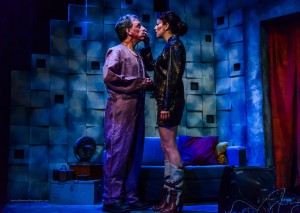 Some of the narrative will be familiar via an earlier adaptation, the 1982 Ridley Scott movie Blade Runner: in a postwar future, Rick Deckard (Eric Curtis Johnson) gets paid to “retire” humanlike androids (Kimberly Atkinson, Emily Kosloski, Rafael Goldstein) manufactured on Mars but outlawed on Earth because they lack the compassion to be trusted among human society. Deckard doubts his own qualifications in that regard, since he kills people for a living and can’t talk to his wife (Lynn Odell) without having a fight. Animals have mostly been irradiated to extinction, so the Deckards are lucky to have an electric pet. Humans have fared little better: the population’s decimated and frequently a little bit mutant (Corey Klemow).
Some of the narrative will be familiar via an earlier adaptation, the 1982 Ridley Scott movie Blade Runner: in a postwar future, Rick Deckard (Eric Curtis Johnson) gets paid to “retire” humanlike androids (Kimberly Atkinson, Emily Kosloski, Rafael Goldstein) manufactured on Mars but outlawed on Earth because they lack the compassion to be trusted among human society. Deckard doubts his own qualifications in that regard, since he kills people for a living and can’t talk to his wife (Lynn Odell) without having a fight. Animals have mostly been irradiated to extinction, so the Deckards are lucky to have an electric pet. Humans have fared little better: the population’s decimated and frequently a little bit mutant (Corey Klemow).
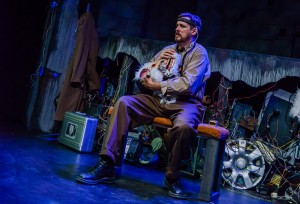 The only two things on television are a ubiquitous corporate shill named Buster Friendly (Marz Richards) and a mysterious messiah called Mercer. Mercer’s virtual-reality “empathy box,” in which one approximates communion by sharing the savior’s suffering, is the centerpiece of a cult that competes with Buster Friendly for the conscience of a public that can only feel emotion by dialing a “mood organ.” The metaphysical circle is complete when Deckard can’t tell whether his co-workers (Mandi Moss and Bruno Oliver), and ultimately he himself, are as human as they pretend.
The only two things on television are a ubiquitous corporate shill named Buster Friendly (Marz Richards) and a mysterious messiah called Mercer. Mercer’s virtual-reality “empathy box,” in which one approximates communion by sharing the savior’s suffering, is the centerpiece of a cult that competes with Buster Friendly for the conscience of a public that can only feel emotion by dialing a “mood organ.” The metaphysical circle is complete when Deckard can’t tell whether his co-workers (Mandi Moss and Bruno Oliver), and ultimately he himself, are as human as they pretend.
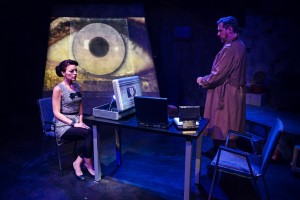 Complementing the ontological subject matter, Mr. Robledo stages more than half the action on big TV monitors (at a grating delay) mirroring the live actors (Anthony Backman, projection design; Hat and Suitcase, motion graphics design; Adam Bitterman, graphic design). Mr. Robledo also freezes many live scenes at the end as if for a commercial break (nicely delineated in Matt Richter’s lighting). But he inexplicably does not stage Mercer’s TV show, nor the visuals of the empathy box experience in which an old man indomitably endures Sisyphean torture. (Only Mercer’s voice is represented, in this production by a voice actor clearly not the same one later introduced as he who plays the character of Mercer on that never-seen TV show. Sloppy.) While Mr. Einhorn’s script doesn’t include these elements of Mercerism either, there’s no reason a director couldn’t correct the oversight. Without a theatrical reference for half of the debate between grim faith and utter cynicism, Buster Friendly wins by default.
Complementing the ontological subject matter, Mr. Robledo stages more than half the action on big TV monitors (at a grating delay) mirroring the live actors (Anthony Backman, projection design; Hat and Suitcase, motion graphics design; Adam Bitterman, graphic design). Mr. Robledo also freezes many live scenes at the end as if for a commercial break (nicely delineated in Matt Richter’s lighting). But he inexplicably does not stage Mercer’s TV show, nor the visuals of the empathy box experience in which an old man indomitably endures Sisyphean torture. (Only Mercer’s voice is represented, in this production by a voice actor clearly not the same one later introduced as he who plays the character of Mercer on that never-seen TV show. Sloppy.) While Mr. Einhorn’s script doesn’t include these elements of Mercerism either, there’s no reason a director couldn’t correct the oversight. Without a theatrical reference for half of the debate between grim faith and utter cynicism, Buster Friendly wins by default.
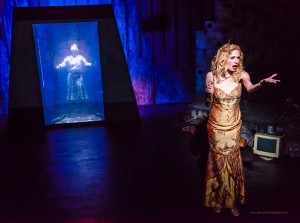 As Friendly, Mr. Richards exacerbates this inequity by giving almost the only thrilling performance in the show. His outsized character beautifully embodies the amorality through which the characters navigate, and his timing, in an extended interaction with a pre-recorded Leon Russom cameo, is a stunt worthy of an android. Unfortunately, his work is embedded in that distracting visual metaphor of multiple foci: it’s hard to know where to look when live performance competes with several monitors repeating onstage business.
As Friendly, Mr. Richards exacerbates this inequity by giving almost the only thrilling performance in the show. His outsized character beautifully embodies the amorality through which the characters navigate, and his timing, in an extended interaction with a pre-recorded Leon Russom cameo, is a stunt worthy of an android. Unfortunately, his work is embedded in that distracting visual metaphor of multiple foci: it’s hard to know where to look when live performance competes with several monitors repeating onstage business.
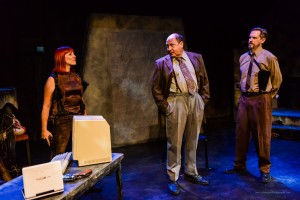 This directorial clumsiness echoes the writer’s tendency toward thin scenes long on redundant message and short on dramatic action. The “android revolution” talked about at length never plays out, and the androids themselves do little more threatening than walk around with their shirts off and spout slogans. Also, oddly, Deckard’s status as human or replicant (for good reason left ambiguous in the book and film, but explicitly resolved by Mr. Einhorn) is framed as the play’s climax, as if the script had built an emotional bridge to the moment. It makes no sense, especially given the alterations the play makes (regarding very human activities like emotional and physical infidelity) to the character.
This directorial clumsiness echoes the writer’s tendency toward thin scenes long on redundant message and short on dramatic action. The “android revolution” talked about at length never plays out, and the androids themselves do little more threatening than walk around with their shirts off and spout slogans. Also, oddly, Deckard’s status as human or replicant (for good reason left ambiguous in the book and film, but explicitly resolved by Mr. Einhorn) is framed as the play’s climax, as if the script had built an emotional bridge to the moment. It makes no sense, especially given the alterations the play makes (regarding very human activities like emotional and physical infidelity) to the character.
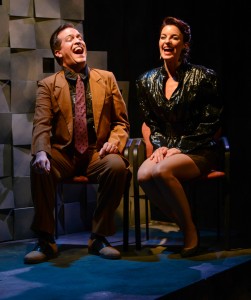 But the various shoot-outs, the nudity, the constant chatter might be entertaining if Mr. Robledo staged it as if it mattered. DeAnne Millais’ cluttered set doesn’t assist concentration, enhancing a mood set by sluggish scenes and clunky changeovers. The directing of actors is almost uniformly unhelpful; the closest most of the cast comes to a character is that they wear Linda Muggeridge’s unsubtle costumes (fedora and topcoat for the detective; slinky gown for the chanteuse). The androids, supposedly hard to distinguish from real people, talk somewhat robotically and rarely change expression – and because we’re not supposed to know who’s a robot, so do the actors playing human. It’s a combination as motile as petrified wood. Emily Kosloski sings Henry Akona’s music with a remarkable voice, and Bruno Oliver’s cop displays the ambiguity missing from the rest of the proceedings. Among the liveliest performances is Elizabeth McIntire’s flirtatious condescension in a TV ad: emigrate to Mars so you can avoid radiation poisoning and exploit robot slaves. But she’s only on for two minutes. Leon Russom is terrific for about three. That’s five of ninety.
But the various shoot-outs, the nudity, the constant chatter might be entertaining if Mr. Robledo staged it as if it mattered. DeAnne Millais’ cluttered set doesn’t assist concentration, enhancing a mood set by sluggish scenes and clunky changeovers. The directing of actors is almost uniformly unhelpful; the closest most of the cast comes to a character is that they wear Linda Muggeridge’s unsubtle costumes (fedora and topcoat for the detective; slinky gown for the chanteuse). The androids, supposedly hard to distinguish from real people, talk somewhat robotically and rarely change expression – and because we’re not supposed to know who’s a robot, so do the actors playing human. It’s a combination as motile as petrified wood. Emily Kosloski sings Henry Akona’s music with a remarkable voice, and Bruno Oliver’s cop displays the ambiguity missing from the rest of the proceedings. Among the liveliest performances is Elizabeth McIntire’s flirtatious condescension in a TV ad: emigrate to Mars so you can avoid radiation poisoning and exploit robot slaves. But she’s only on for two minutes. Leon Russom is terrific for about three. That’s five of ninety.
photos by Jessica Sherman Photography
Do Androids Dream of Electric Sheep?
Sacred Fools Theater Company
scheduled to end on Saturday October 19, 2013
for tickets, call (310) 281-8337 or visit http://www.sacredfools.org
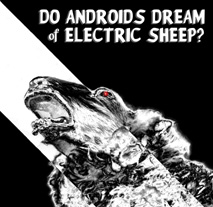

{ 1 comment… read it below or add one }
This looks to be awesome! I hope I get a chance to see it.